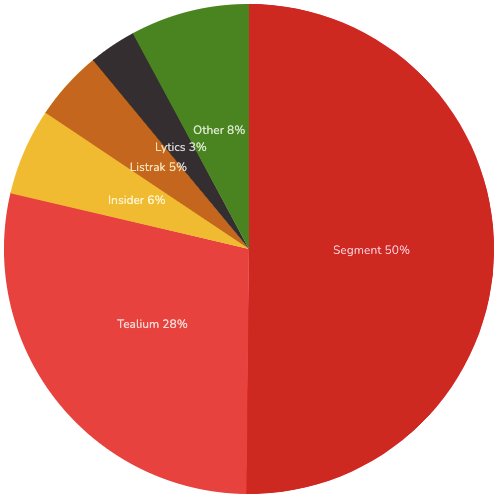Who uses this technology?

General usage
Social media, email, apps, online help desks and other digital platforms have fragmented the customer experience. Applications need a tool to coordinate all those customer touchpoints to gain better insights and deliver better user experiences.
Segment does this in four stages:
- Data collection from different sources, e.g. mobile apps, websites, payment gateways, and help desks. Segment provides quick integration with hundreds of applications.
- Data validation and transformation so data is accurate and reliable
- Data processing (combining and segmenting data) to create more complete customer profiles and discover how users navigate through different stages and touchpoints.
- Data activation by distributing processed data to other tools or teams, e.g. CRMs, email marketing tools, or advertising platforms.
This process unifies your customer’s touch points across all platforms and channels, which enables a better understanding of the user journey. It allows the creation of audience personas by combining various data points, e.g. events that put customers in a specific position and customer traits such as last product bought.
Marketing teams can now target a specific customer segment with the right message at the right time via the right channel. It also enables a more personalised, consistent, real-time customer experience across all touch points.
Popularity
Segment is used as a customer data platform by half of the top one million sites in the world:

Source: Builtwith
Marketplace benefits
CobbleWeb has integrated Segment for clients who want to improve their marketing pipeline. It allows us to pull customer data from different sources into one repository before distributing it to multiple marketing tools.
Instacart has three types of users: customers, personal shoppers, and retail shops. They used Segment to collate data from all the channels (platform, apps, email, and helpdesk) they use to better understand how they interact with each other. Sendgrid made it easy to pull data from the various data sources such as SendGrid and Zendesk.
The combined data helped Instacart to understand where users got stuck and how Instacart can help them smooth their interactions. For example, they discovered that some customers were opting out of the ordering process at a certain stage. The fix was to insert customer support managers at that stage to help them before they leave.
Peerspace is a P2P marketplace for meeting and event venues. They wanted to address different types of customers in a personalised yet scalable manner to maintain high conversion rates. Segment was implemented to capture and digest event and conversion data, which was then shared with different team functions such as paid acquisition and A/B testing.
Peerspace also combined Segment data with Mutiny (a tool that identifies visitors according to certain attributes, e.g. industry, funnel stage, and web activity) to personalise Peerspace’s landing pages. Thus a business person in NYC will see venues with business equipment, while a recently engaged couple will see wedding venues. This personalisation increased user signups by 98%.
We're here to help!
Would you like to know more about the suitability of a particular technology for your marketplace? Get in touch for a free audit and recommendations.